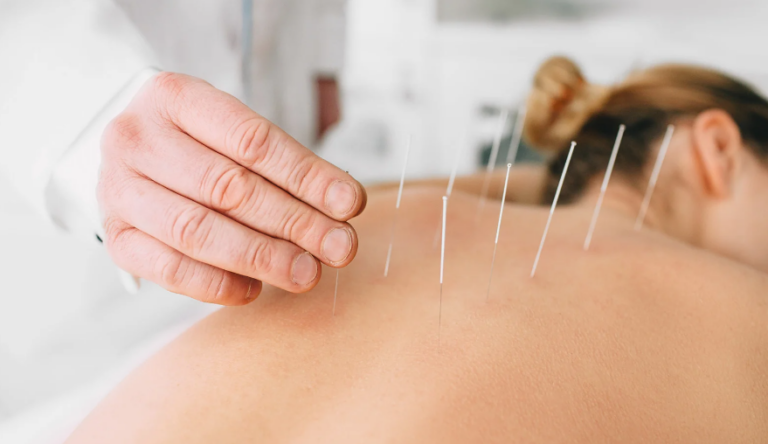Introduction
Acupuncture has been practiced for thousands of years. It originated in ancient China as a core part of Traditional Chinese Medicine (TCM). In recent decades, it has gained popularity in Western healthcare, including multi-disciplinary clinics. Many people now turn to acupuncture to relieve pain, reduce stress, and support healing.
Scientific research continues to support its safety and effectiveness. Today, acupuncture is considered an evidence-based therapy that can complement both conventional medicine and rehabilitation.
How Acupuncture Works
Acupuncture involves inserting very thin, sterile needles into specific points on the body called acupoints. According to TCM, these points lie along meridians that carry energy—or “qi” (pronounced “che”)—throughout the body.
From a biomedical perspective, acupuncture stimulates the nervous system, improves circulation, and triggers the release of endorphins and serotonin. The procedure is minimally invasive, nearly painless for most patients, and highly customizable.
Key Benefits of Acupuncture
- Pain Relief: One of acupuncture’s most studied benefits is pain reduction. Research shows it can help with: chronic low back pain, osteoarthritis (particularly of the knee), neck pain, and headaches and migraines.
- Improved Physical Function: For physiotherapy patients, acupuncture can enhance results. It helps reduce muscle tension and pain, which improves mobility and function. For example, acupuncture has been shown to increase joint flexibility and walking speed in people with knee osteoarthritis (White et al., 2007). Combining acupuncture with manual therapy or exercise rehab may accelerate recovery more than using either treatment alone.
- Stress and Anxiety Reduction: Acupuncture has calming effects on the nervous system. It reduces sympathetic activity (the “fight or flight” response) and enhances parasympathetic activity (the “rest and digest” response). This makes it useful for managing stress, anxiety, and sleep issues. Functional MRI studies show acupuncture can alter brain activity related to pain and emotional regulation (Hui et al., 2000). A 2013 study in the Journal of Endocrinology also found it reduces cortisol, the body’s primary stress hormone (Eshkevari et al., 2013).
- Enhanced Healing and Functional Control: Acupuncture increases blood flow, supports tissue repair, and helps regulate inflammation. This makes it especially helpful for sport injuries, repetitive strain injuries, post-surgical recovery. Studies show it can reduce inflammatory markers like cytokines and C-reactive protein (Zijlstra et al., 2003). This may help decrease swelling, speed healing, and lower the risk of chronic pain.
- Support for Chronic Conditions: Beyond physical injuries, acupuncture may also help with ongoing health issues such as fibromyalgia, irritable bowel syndrome (IBS), tension-type headaches, and menstrual pain or hormonal imbalances. It offers a drug-free way to manage symptoms that don’t always respond well to medication or lifestyle changes alone.
Conclusion
Acupuncture is more than a traditional healing practice. It’s a scientifically supported therapy that fits well within a modern physiotherapy setting. Whether you’re recovering from injury, managing a long-term condition, or simply trying to feel better, acupuncture can be a valuable part of your treatment plan.
At All In Physiotherapy, Sport & Wellness, we personalize each session to your unique needs and goals. Many of our clients benefit from combining acupuncture with physiotherapy for a well-rounded, holistic approach to care
References:
- Eshkevari, L., et al. (2013). Acupuncture blocks cold stress-induced increases in the hypothalamus–pituitary–adrenal axis in the rat. Journal of Endocrinology, 217(1), 95–104. https://doi.org/10.1530/JOE-12-0313
- Hui, K. K. S., et al. (2000). Acupuncture modulates the limbic system and subcortical gray structures of the human brain: evidence from fMRI studies in normal subjects. Human Brain Mapping, 9(1), 13–25. https://doi.org/10.1002/(SICI)1097-0193(200001)9:1<13::AID-HBM2>3.0.CO;2-F
- Vickers, A. J., et al. (2012). Acupuncture for chronic pain: individual patient data meta-analysis. Archives of Internal Medicine, 172(19), 1444–1453. https://doi.org/10.1001/archinternmed.2012.3654
- White, A., et al. (2007). Acupuncture treatment for chronic knee pain: a systematic review. Rheumatology, 46(3), 384–390. https://doi.org/10.1093/rheumatology/kel413
- Zijlstra, F. J., et al. (2003). Anti-inflammatory actions of acupuncture. Mediators of Inflammation, 12(2), 59–69. https://doi.org/10.1080/0962935031000114030
Disclaimer: This blog is intended for general educational purposes only and does not constitute medical advice. For personalized assessment and treatment, please consult a licensed healthcare professional.

